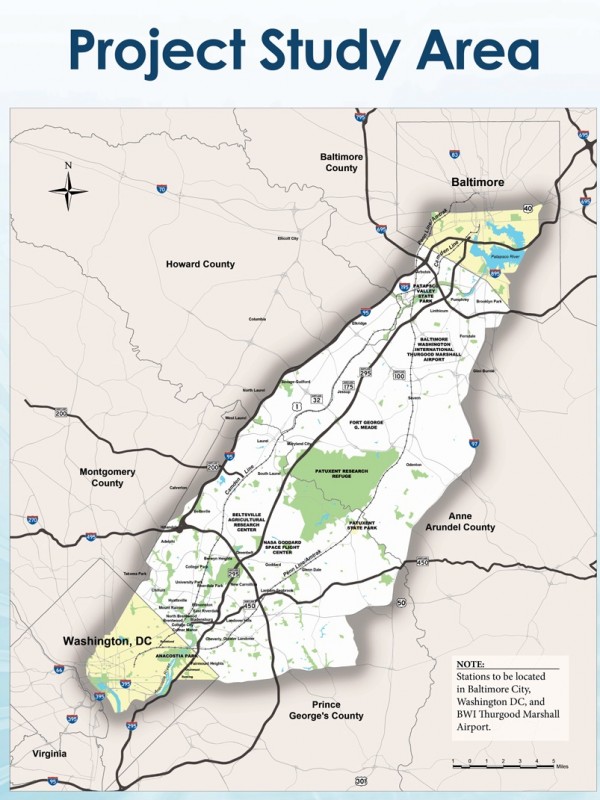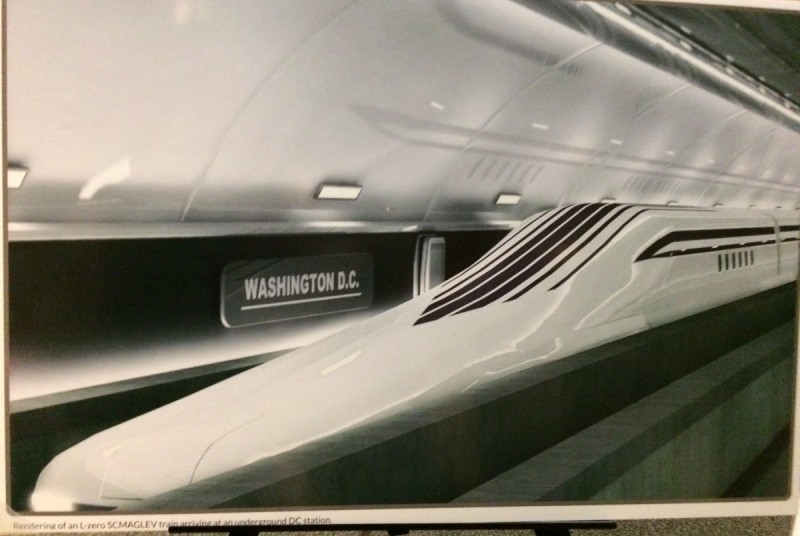The idea for a maglev train from DC to Baltimore keeps…floating down the track

Image by Baltimore Washington Rapid Rail used with permission.
Remember that futuristic rail project that was going to shuttle you from Washington to Baltimore in 15 minutes, and after that, to New York in an hour? It was questioned by critics as a pie-in-the-sky white elephant project, but it’s still around, and last month, the people who want to build it put forth a few more details.
Superconducting maglev trains (“SCMAGLEV,” to be even more precise) are a rail technology that eschews rails, instead sitting within a concrete guideway. Trains are surrounded by superconducting magnets on each side, causing them to “float” in the guideway. The train actually does rest on rubber tires, which are used at low speeds (up to 70 mph), but the tires are retracted at higher speeds to reduce resistance, much like an airplane taking off.
The inherent advantages to such a rail line, once built, are a smooth ride at speeds competitive with an airliner (this project is targeting 500 km/h, or 311 mph) but without the weather issues that delay air traffic, and a strong safety record; there have been just two fatalities, both on an early test track, and due to operator error, which is far better than many other transportation modes.
The disadvantages are the costs— building one would be really expensive— along with the fact that just spending time thinking about something so difficult to pull off distracts from more pressing priorities.
The Baltimore-Washington Rapid Rail (BWRR) organization held a series of open houses across the region in December to showcase the work that they have done so far, and solicit general public comment on their Environmental Impact Statement (EIS).
What would a maglev train look like here?
The current proposal would serve two purposes: It would be a chance to prove that a maglev project is feasible in the United States, and it would be a functional transit service. Trains would stop in downtown Washington, BWI Airport, and downtown Baltimore.
While BWRR's project team was clear that a specific route isn't on the table yet, the area where the agency is considering building a maglev is bound roughly by 1-95 on the west, and I-97 on the east, stretching between both downtowns.
Image by Baltimore Washington Rapid Rail used with permission.
BWRR Senior Director Robert Kiernan says that it’s likely that more than half the route will be underground. “Tunnel technology has improved significantly in the last 25 years,” Kiernan says, “and we obviously need a very straight track, which is hard to find above ground in the study area.”
The maglev would carry riders from Washington to BWI in nine minutes, and it would only take another six minutes to get to Baltimore. (It would take the train two minutes and 20 seconds to accelerate to full speed, and two minutes to brake, so the BWI-BAL run would be at full speed for just 100 seconds.) Present-day MARC trains take 26 minutes to get to BWI, and another 19 to Penn Station, on the northern edge of downtown Baltimore, and Amtrak's Acela Express takes 21 and 13, respectively.
| Rail Service | MARCA | Acela | MAGLEV |
|---|---|---|---|
| Washington to BWI | 26 | 21 | 9 |
| BWI to Baltimore | 19 | 13 | 6 |
| Washinton to Baltimore (no stop at BWI) | 37 | 30 | 11* |
* This number is an estimate for how long it'd take a train to run from Union Station in DC to Penn Station in Baltimore, but that won't actually happen. As long as the line runs just between Washington and Baltimore, every train would stop at BWI, and there would be no “express” trains. “Our ridership studies found that a significant portion of the ridership for this line would be boarding or alighting at the airport, so we will never skip that stop” said Furqan Siddiqi, the Executive Vice President of BWRR.
To Baltimore…and beyond!
At the open house I attended, the project team made no secret of their eventual desire to see the line continue to New York City. Just like BWI provides a critical connection, the extended line would connect to airline hubs in Philadelphia and Newark, along with the holy grail of the large cities in the Northeast Corridor being within less than an hour of each other. No one on the team would refer to this as “Phase Two” of the project, because they had no idea how many phases, if any, would be built after the initial Washington to Baltimore line is in operation.
Interestingly, this expansion does propose an express routing that would stop only in Washington, Philadelphia, and New York. Unlike a conventional railroad, maglev tracks don’t cross each other at full speed, so any switching to a track that bypasses a station would have to be done at lower speeds, likely near that station. That makes it unclear how much time the express service would save.
Image by Baltimore Washington Rapid Rail used with permission.
Japan is willing to pay for half the project in hopes it catches on, but who would fund the other half?
The $10 billion dollar question for the entire project is the funding source. The Japan Bank of International Cooperation (JBIC) has offered to pay half the cost of the DC to Baltimore line. The remainder of the initial funding would come from a yet-to-be-identified mix of (American) federal, state, and private sources.
“In Japan,” said Kiernan, “the level of national pride in high speed rail is similar to American pride in the space program. They are excited to share it with the rest of the world” In paying for a line here, the Japanese government is taking a calculated risk that if they can get a project in the United States up and running, it will lead to more export business in other parts of the U.S., and around the world.
It is clear that there are many unanswered questions to be answered before this project ever breaks ground, including fare structure (would this service be affordable to a critical mass of users), competing funding needs (the estimated cost for this project would consume the Maryland Department of Transportation’s capital budget for about four years), and the details of the construction process. There would also need to be dedicated funding via either fares or government support to repay JBIC for its initial investment.
With that said, BWRR says bringing major markets closer together would have a significant economic impact if it ever happens, as construction would mean jobs and the functioning line would join major financial hubs.
Image by Baltimore Washington Rapid Rail used with permission.
If you would like to comment on any aspect of the project, the Federal Railroad Administration and Maryland Department of Transportation are accepting comments until January 9, 2017. Go here to view meeting materials and comment online, or e-mail comments to info@baltimorewashingtonscmaglev.com.
Could Matt Johnson soon be publishing a "Which Maglev?" series? Image by Baltimore Washington Rapid Rail used with permission.
